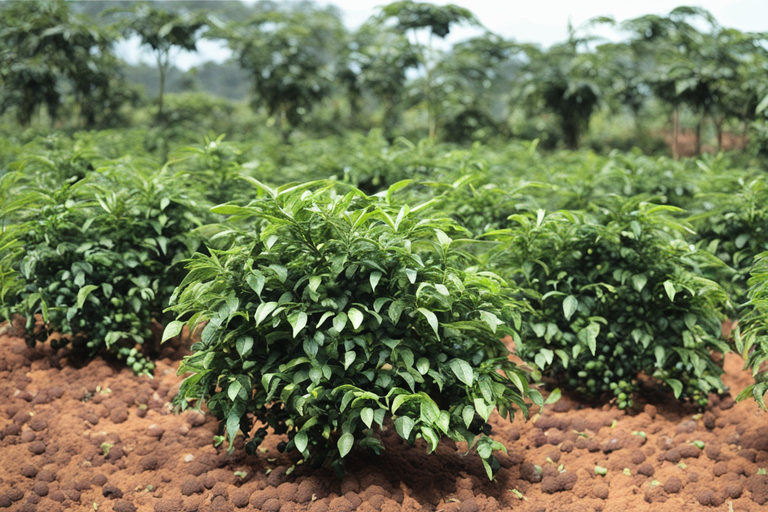
Black Pepper Farming: Cultivating the “King of Spices”
Black pepper, famously dubbed the “King of Spices,” boasts a storied past stretching back millennia. This flavorful wonder isn’t just a kitchen essential globally, it’s also a prized cash crop. In this comprehensive manual, we’ll explore the realm of black pepper farming, encompassing its cultivation, stages of growth, pest control, harvesting, and beyond.
Introduction to Black Pepper Farming
Black pepper, scientifically named Piper nigrum, is a climbing vine that naturally grows in South India. It prefers tropical regions with consistent rainfall and even temperatures all year round. This remarkable plant gives rise to tiny round fruits called peppercorns, celebrated for their bold and spicy taste.
Climatic Requirements
Successful black pepper cultivation hinges on the right climate. Here are the key climatic factors to consider:
- Temperature: Black pepper thrives in temperatures between 75°F and 85°F (24°C to 30°C).
- Rainfall: Adequate rainfall, ideally around 2000-3000 mm annually, is essential for black pepper farming. However, it requires a dry period for fruiting.
- Altitude: Black pepper is typically grown from sea level to 1500 meters.
Soil Preparation
Black pepper prefers well-drained, loamy soil with good organic content. Here’s a step-by-step guide to soil preparation:
- Land Selection: Choose a land with partial shade to protect the vines from direct sunlight. You can also consider using a Preet Tractor to maintain the ideal growing conditions for the black pepper vines, such as land preparation, irrigation, and transportation within the farm.
- Checking Soil Quality: Examine the soil’s pH and nutrient composition. Adjust the pH within the optimal range of 5.5 to 6.5 if needed.
- Creating Planting Spaces: Next, dig pits or trenches that are approximately 60 cm deep and 60 cm wide. Keep a spacing of 2-3 meters between each of these pits or grooves.
- Compost and Manure: Incorporate well-rotted organic matter into the soil to improve fertility.
- Support Structure: Erect support structures, like stakes or trellises, for the pepper vines to climb.
Propagation
Black pepper is propagated through cuttings. Here’s how:
- Cutting Selection: Choose healthy, disease-free vine cuttings with at least two nodes.
- Cutting Preparation: Dip the vine into 2-3 node sections in a rooting hormone.
- Planting: Plant the cuttings in pits or trenches, ensuring one node is below the soil surface.
Growth Stages
Black pepper goes through various growth stages, each requiring specific care:
- Vegetative Stage: This stage lasts 3-4 years, during which the vines grow and develop.
- Flowering and Fruiting Stage: Flowering typically occurs in the second year, and fruiting begins in the third year. The flowering stage requires a dry period, and proper pollination is crucial.
- Maturity Stage: Full maturity is reached in 5-6 years, and the vines can produce pepper for up to 30 years.
Cultivation Practices
Maintaining a healthy black pepper plantation involves the following practices:
- Watering: Provide consistent moisture, especially during dry spells. However, avoid waterlogging, as it can harm the roots.
- Weed Control: Keep the plantation weed-free to prevent competition for nutrients and water.
- Nutrient Management: Apply balanced fertilisers and micronutrients as per soil test recommendations.
- Pruning: Regularly prune the vines to promote growth and facilitate harvesting.
Pest and Disease Management
Black pepper is susceptible to various pests and diseases, including:
- Thrips and Mites: Use neem-based pesticides or organic solutions to control these pests.
- Phytophthora Root Rot: Maintain well-drained soil to prevent this fungal disease.
- Anthracnose: Apply copper-based fungicides to manage anthracnose.
- Scale Insects: Control scale insects using horticultural oil sprays.
Harvesting
Black pepper harvesting is a labour-intensive process. Here’s how it’s done:
- Ripeness: Harvest the peppercorns when they turn yellow or red, depending on the variety.
- Handpicking: Pluck the ripe peppercorns from the vines carefully.
- Drying: Spread the harvested peppercorns in the sun for 5-7 days, turning them regularly. This drying process is essential for developing the classic wrinkled appearance.
- Winnowing: Remove the outer husks from the dried peppercorns.
- Grading and Packaging: Sort the peppercorns by size and package them for sale.
Post-Harvest Handling
Proper post-harvest handling is crucial to maintain the quality of black pepper:
- Storage: Store dried peppercorns in a cool, dry place away from direct sunlight.
- Packaging: Use airtight containers to prevent moisture and flavour loss.
Market and Export Opportunities
Black pepper is a valuable export commodity for India. It is in high demand worldwide for its culinary uses and medicinal properties. Indian black pepper is renowned for its quality, making it a sought-after product globally.
Challenges in Black Pepper Farming
While black pepper farming offers numerous benefits, it also comes with challenges:
- Pest and Disease Pressure: Managing pests and diseases requires vigilance and proper care.
- Price Volatility: Pepper prices can fluctuate, affecting growers’ income.
- Labor Intensity: Harvesting and post-harvest processing require significant manual labour.
Conclusion
Black pepper farming is a rewarding venture with a rich history and a promising future. With the right climate, soil, and cultivation practices, you can cultivate this “King of Spices” and contribute to the global demand for this versatile and flavorful crop.
Utilising the efficiency of a John Deere Tractor can greatly enhance the productivity of your farm. While challenges exist, the potential for profit and the satisfaction of growing such a coveted spice make black pepper farming worthwhile.



